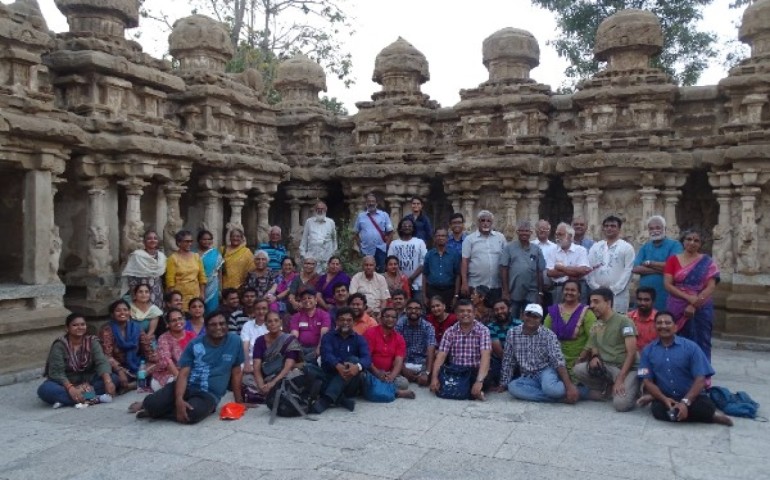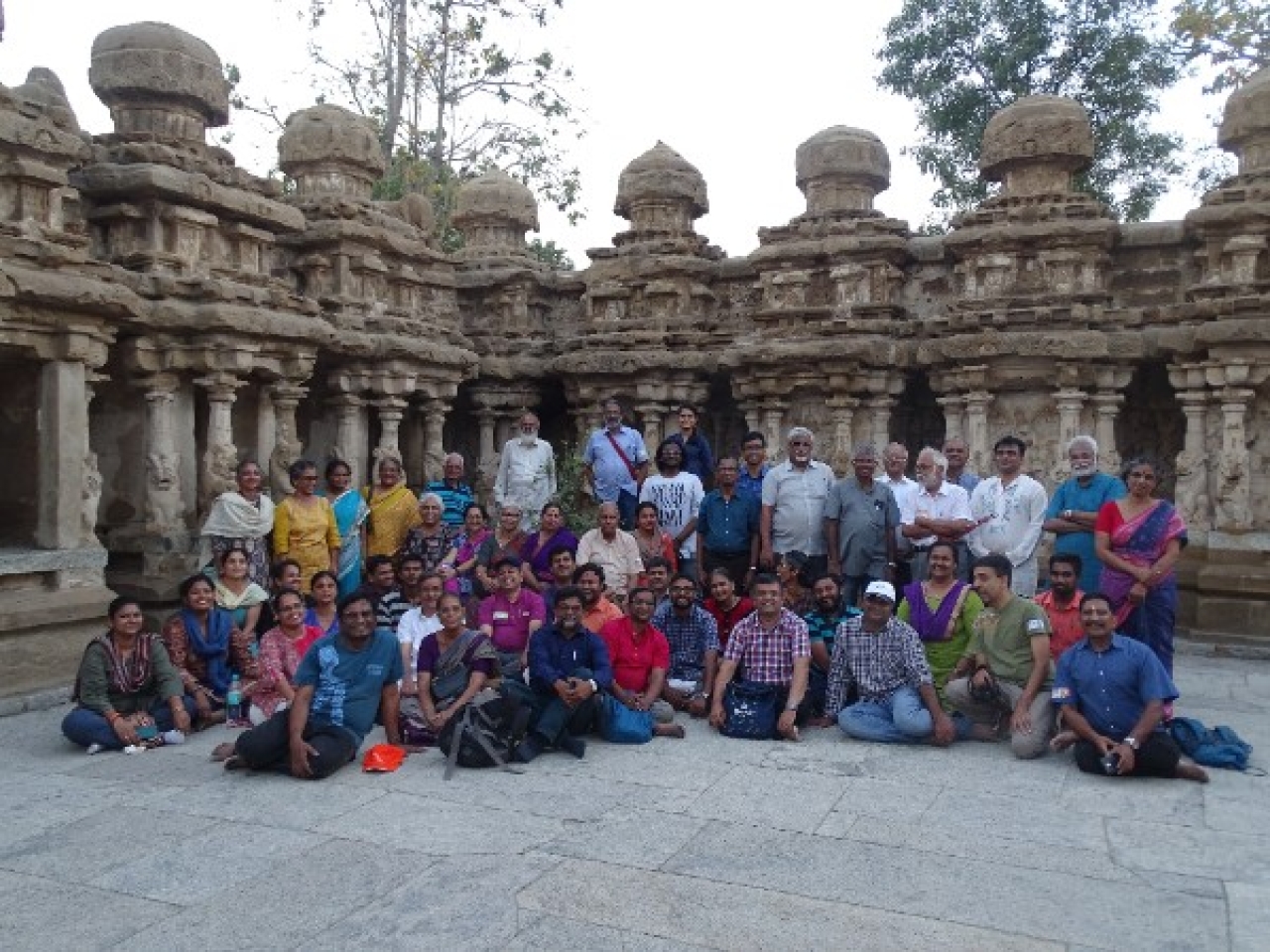Come December each year, melodies abound in Chennai, with kacheris (concerts) held in various parts of the city. But for the last six years, there is a unique kacherithat is held every year, which is music to the ears of heritage enthusiasts, the “Pechu Kacheri” (literally – “Talk Concert”).
The Tamil Heritage Trust (THT), to go beyond music and celebrate other aspects of our cultural heritage, organises a two-day colloquium called the Pechu Kacheri. The kacheri sees doyens of art, architecture, literature, archaeology, and the like deliver talks that have depth and passion and come from years of involvement in the fields.
The past kacheris have had different themes, ranging from ‘Tamil heritage from Sangam days’ in 2011, ‘Indian Paintings – a tour of 10,000 years’ in 2012, Srirangam as a heritage hub in 2013, Dr Nagaswamy and his multi-faceted contribution to heritage in 2014, to Mamallapuram in 2016.
Aptly titled ‘Kanchi Mahaamani’, the programme, in its sixth year (2017), was a celebration of Kanchipuram – its glorious history and great kings and artists, with the first talk of the session delivered by the director of archaeology (retired) and former vice chancellor of Kanchipuram University, Padma Bhushan Dr Nagaswamy.
This was, however, a part of the larger Kanchi-themed activities that the Trust was holding through the year, which culminated in the site study tour called ‘Nagareshu Kanchi’ in the last week of January. Having been on the study tour with this group, I can vouch for the service that they are rendering to preserve, protect, and promote heritage and its study with all sincerity.
Every year for the past seven years, the Trust in Chennai has been organising the site study tour along with year-long activities around heritage, from monthly talks by specialists to heritage workshops.
It is amazing how individuals from varied backgrounds have now woven a fabric of heritage and culture in the city. A brainchild of professor S Swaminathan, who served as a faculty at IIT Delhi, and publisher Badri Seshadri, THT is a voluntary organisation with a core team that has teachers, publishers, writers, entrepreneurs, information technology professionals, bankers, students, and home makers. The more varied the backgrounds, the more varied are the perspectives they bring to the pursuit of their common goal – heritage.
A variety of people come on board each year for the site seminar. The participants are writers, architects, biologists, urban planners – and so what each one takes back from the study tour depends on the prism that they access it from.
Whether it is wondering what kind of binders would have been used in the paintings on the walls of ancient structures, to those decoding the myths in the stories in stone, the patterns in the structures, to the politics at play, to the art of restoration, or whatever takes place in the name of it.
And no novice has to struggle to find their feet as the orientation lectures that are held every Sunday in Chennai for four months in the run-up to the site seminar make sure one has a broad outline of the entire subject.
As one venturing into heritage only recently, I had my reservations about being a part of a study tour that would cover around 26 temples, all heritage structures, in four days.
But the THT team should be applauded for its organisational skills that ensured that there were no signs of either physical or mental fatigue, what with having to cover almost six sites in a day and each explored in depth.
Additionally, the resource persons that THT has on board – the likes of architect Madhusudhan Kalaichelvan, professor Shankar Narayanan, technical historian Gopu Rangarathnam – were not just erudite but also deeply passionate about ensuring that their knowledge translated into the participant’s understanding of the subject in a short span of time. If I could tell a Pallava temple from a Chola one and spot a Dakshinamurthy sculpture even from its damaged remnants, or fall in love with the bhootaganas, which were each different from the other, you know the trip has been a successful one.
The site seminar is just one of the various activities that THT undertakes to create awareness of the rich cultural heritage that it takes pride in. Its other efforts include:
– Monthly lectures on various aspects of heritage on the first Saturday of every month
– Monthly study tours to heritage sites – at present to Mallai and soon to Kanchi
– Regular presentations at schools to sensitise the young about our heritage
– Co-ordination with government culture and tourism agencies for supplementing their efforts
The Trust also has a system in place to ensure this romance is instilled not just in a handful of people in the know but also to those that seek to do. The monthly study tours create docents or voluntary guides who are trained for over three months, enabling them to take heritage to many more people.
“We started this from March 2016 and chose Mallai as the first site. The next four months were spent on selecting 15 volunteers, preparing the guide books for the docents and the participants, having detailed training over four weeks on various aspects of Mallai and then two weeks in site walkthroughs and dry runs at Mallai followed by reverse presentations moderated by mentors and an objective type questionnaire to qualify as docents,” explains THT member Sivasankar Babu.
The monthly lectures, which are also cast live online for those that cannot attend them in person, delve into various topics from history, sculpture, languages, and scripts to epigraphy, temple architecture, art, and some special areas like heritage tourism, history through coins, and the ancient science of water management. The session to be held on 3 March is titled ‘How legal systems evolved from ancient time’.
Having not watched all the preparatory lectures, a few due to the language barrier, I had my doubts when I alighted the bus at Kanchipuram. But then, a dossier of sorts, a collection of articles by all resource persons, along with maps and guides to identify various sculptures in the temples that we would be visiting, was handed to every participant.
Armed to explore was every single person, and how.
The tour, which is normally held around the Republic Day weekend, “aims to inspire people passionately interested in Indian heritage to study in depth and detail, the patrimony of artistic heritage – temples, monuments, paintings, sculptures, literature, epigraphs – that we have inherited, but are barely aware of; to visit such places and imbibe the spirit of its creators; to soak in the scholarship of experts and researchers; to absorb the aesthetics and the history; and to pass it on to our colleagues and friends, families, and future generations.”
Having taken in all the research and effort that THT put into acquainting me with Kancheepuram, I can, in an extension of Kalidasa’s lines, “Pushpeshu jati, purusheshu Vishnu; narishu Rambha, nagareshu Kanchi (Of flowers it is jasmine, of men Vishnu, of ladies Rambha, of cities Kanchi)”, say: rasikeshu THT!
















No Comment